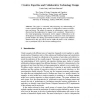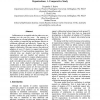AH
2008
Springer
14 years 2 months ago
2008
Springer
The evolution of learning systems brought improvements to the functionality of their components by offering support and mediating learning, communication and collaboration. However...
APCHI
2004
IEEE
14 years 4 months ago
2004
IEEE
The paper is concerned with increasing our understanding of creative expertise drawing upon studies of collaboration between technologists and artists. The nature of expertise in c...
AUSAI
1997
Springer
14 years 4 months ago
1997
Springer
Abstract. Autonomous agents decide for themselves, on the basis of their beliefs, goals, etc., how to act in an environment. However, it is often the case that an agent is motivate...
HICSS
2002
IEEE
14 years 5 months ago
2002
IEEE
One trend in day-to-day computing involves moving seamlessly from large powerful workstations to small handheld devices. A second trend is continuous collaboration with colleagues...
HICSS
2002
IEEE
14 years 5 months ago
2002
IEEE
This paper describes our experiences in an ongoing collaboration between our research group in Palo Alto and a similar group in Japan. The collaboration is based on semimonthly vi...
C5
2010
IEEE
14 years 5 months ago
2010
IEEE
Efficient collaboration and task management is challenging in distributed, dynamically-formed organizations such as ad hoc disaster response teams. Ineffective collaboration may r...
ATAL
2003
Springer
14 years 5 months ago
2003
Springer
According to the taxonomy for agent activity, proposed by V. Parunak, a collaboration is an interaction between agents of a multi-agent system (MAS) whereby the agents explicitly ...
GROUP
2003
ACM
14 years 5 months ago
2003
ACM
Loose coupling is a common way of organizing collaboration in work groups, but it has not been studied extensively in CSCW. In this paper, we consider the patterns of work that ar...
HICSS
2003
IEEE
14 years 5 months ago
2003
IEEE
This paper describes the design and evaluation of COLER, a computer mediated learning environment that includes a software coach to help students collaborate while solving Entity ...
HICSS
2003
IEEE
14 years 5 months ago
2003
IEEE
Collaboration to accomplish tasks has taken on a new meaning over the past few years. The majority of organizations are viewing information technology (IT) as a key enabler to tra...






